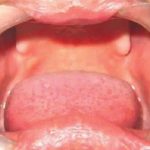 Rare dental condition characterized by congenital absence of all teeth (both deciduous and permanent). Compare: Hypodontia, Oligodontia.
Rare dental condition characterized by congenital absence of all teeth (both deciduous and permanent). Compare: Hypodontia, Oligodontia.
A total or partial absence of teeth, usually due to heredity. Total anodontia is a rare condition in which the primary teeth or the permanent teeth fail to develop. In this case, some teeth may be present but they are cone-shaped or malformed. Partial anodontia is a more common condition that involves the lack of one or several permanent teeth, often the third molars. Primary teeth are usually not affected. The condition is sometimes referred to as hypoplasia of the dentition. Possible causes, in addition to heredity, include nutritional disturbances during the mother’s pregnancy or the child’s infancy, endocrine disorders, and diseases such as rickets and scarlet fever. When permanent teeth do not appear after the primary teeth have come out, the most frequent causes are accidents that have damaged the gums or bone, or early tooth decay. The molars and premolars have natural grooves that tend to trap the bacteria that cause decay. In some instances, the permanent teeth simply fail to develop or, due to dental impaction, cannot grow through the gum tissue. Any missing teeth can eventually cause problems and should be evaluated by a dentist, who will probably recommend a bridge or denture.
Absence of the teeth. It may affect both the milk teeth (primary dentition) and the adult teeth (secondary dentition) or only the latter, and some or all teeth may fail to develop.
Anodontia refers to the failure of certain or all teeth to develop. It can manifest as partial or complete absence of teeth and may occur due to the absence of tooth buds from birth or as a consequence of damage to developing tooth buds caused by infection or systemic diseases. This condition can affect both primary and permanent teeth, although partial anodontia is significantly more prevalent than total anodontia.
In cases where only a small number of teeth are missing, a dental bridge can be utilized. This involves attaching false teeth to the natural teeth on either side of the gap. Conversely, if all teeth are absent, the use of dentures is necessary. However, in recent times, dental implants have emerged as the preferred treatment option for specific individuals who possess the appropriate anatomy and optimal bone density.
